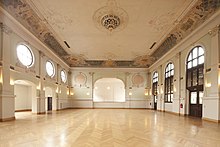Ballhaus Pankow
The Ballhaus Pankow is a single monument in Berlin's Pankow district, Niederschönhausen .
history
The Ballhaus Pankow was built in 1880 on behalf of the innkeeper August Lehder. He initially had a single-storey building erected on the property at Lindenstrasse 11 (since 1936: Grabbeallee 53) on the corner of Kaiserin-Augusta-Strasse (since 1950: Tschaikowskistrasse). After completion of the first construction phase, there were guest rooms, a small hall and some living rooms. Initially, the company was called the Restaurant Schloss Schönhausen , named after the nearby Schönhausen Palace , one of the residences of the Prussian royal family. At that time, the Ballhaus was still at the gates of the rapidly growing city of Berlin. In the area along Lindenstrasse there were a few other excursion restaurants at that time.
Business in the restaurant was good. In 1892 August Lehder had the existing building expanded to include a few new areas, including an approximately ten-meter high ballroom . In particular, this spectacular hall with its splendid ceiling painting, stucco and parquet soon made the excursion restaurant a sight. A large conservatory in the timber-framed and bar were built immediately adjacent to the ballroom. Shortly before the turn of the 20th century, August Lehder placed the fate of the Ballhaus Pankow in the hands of his son-in-law August Donath. In the following years it was used as a dance and entertainment venue under various owners. The last restaurant was closed in 1933. Then there were inheritance disputes, so that the property was foreclosed .
The ensemble of buildings survived the Second World War almost unscathed. The Ballhaus served as a production site between 1945 and 1989. In the immediate post-war years, steel helmets were forged into cooking pots here . Later a locksmith's shop and then a mechanical engineering company moved in. The careless handling of the building fabric meant that the Ballhaus in 1989, at the time of the fall of the Wall , was in a catastrophic state. The roof and walls were largely rotten. The building was on the verge of decay. Nevertheless, it was placed under monument protection and between 1993 and 1995 a new owner restored it at great expense for around five million euros . Public subsidies were also used, as there was considerable public interest in restarting the ballroom. The following excerpts from a letter from the Berlin Senate Department for Urban Development and Environmental Protection from 1993 are in this context : " ... It is (note: the Ballhaus) today an extremely rare example of a restaurant in north Berlin that was built in the late 19th century " and " ... the real concern of the city district is the protection of the old ballroom - triggered by a citizens' initiative - and its reconstruction as a cultural and gastronomic center ". The Ballhaus Pankow is "one of the most beautiful and oldest still preserved buildings in the Pankow district, [...] one of the last evidence of a time when Pankow was still a destination in the countryside."
Since the extensive reconstruction of the Pankow ballroom was completed in 1995, the building has remained largely unused, partly due to the high rent demands of the previous owners. The Friends of the Chronicle of Pankow eV criticized in 2000 the lack of a concept for event operations and suspected "that the owner of the Ball House are primarily interested in the property had to build there homes." Occasionally found private individual events with up to 500 guests. The public was only rarely able to look inside the building, for example during walks in the neighborhood and on the day of the open monument . The auction by Liegenschaften GmbH on March 22, 2013 received no bid.
Since December 2014, cultural events have been taking place in the Ballhaus again. The event organizer and restaurateur Ronald Kucharski started on December 6, 2014 with an Advent gala and has since been presenting artists from the genres of classical, jazz, pop, hit and rock in loose succession. On March 25, 2015 Udo Lindenberg performed in the baroque ballroom. His concert was the end of a trip with the " special train to Pankow " (in this case with a train on underground line 2). This fulfilled his wish, which he had formulated 32 years earlier in the song of the same name.
Web links
- Entry in the Berlin State Monument List
- Ballhaus Pankow Liegenschaften GmbH
- No invitation to dance? . In: Berliner Zeitung, September 29, 1995
- Mathias Raabe: Extensively renovated and yet empty . In: Berliner Zeitung, March 9, 2000
- Ballhaus Pankow celebrates reopening! In: Berliner Zeitung, November 18, 2014
Individual evidence
- ↑ Ballhaus Pankow ( Memento of the original dated February 3, 2016 in the Internet Archive ) Info: The archive link was inserted automatically and has not yet been checked. Please check the original and archive link according to the instructions and then remove this notice. Stadtwandel Verlag
- ^ Quote from Claudia Dörries in Die Neue Architekturführer, No. 171 (Stadtwandel Verlag, Berlin)
- ^ Mathias Raabe: Extensively renovated and yet empty . In: Berliner Zeitung, March 9, 2000
- ^ Report in Berliner Abendschau on March 22, 2013.
Coordinates: 52 ° 34 ′ 34.4 " N , 13 ° 23 ′ 51.1" E


